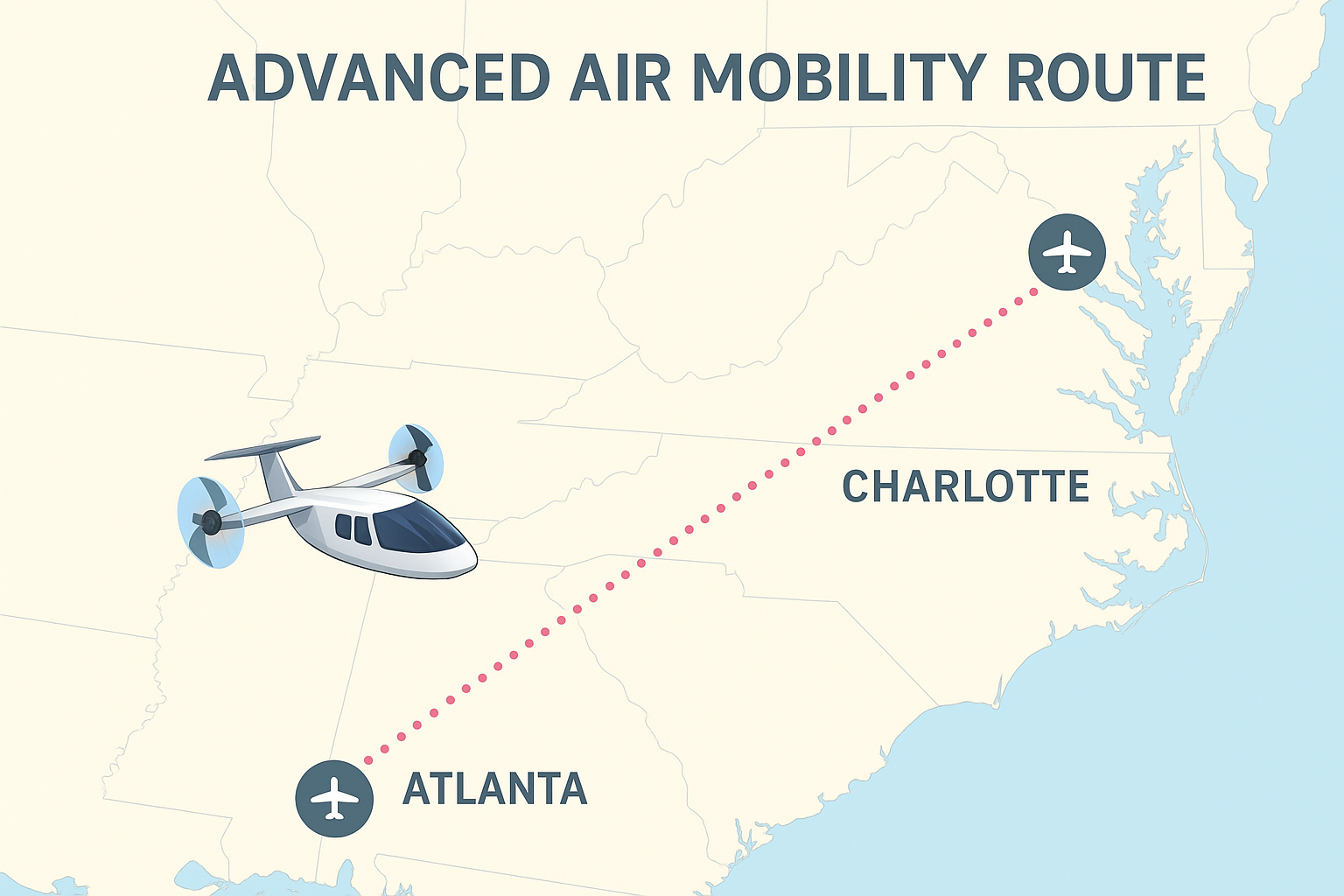The North Carolina-Georgia advanced air mobility corridor represents far more than a regional transportation project; it’s likely to become the model for how the United States approaches the low-altitude economy at scale. This first interstate “sky highway” will influence national strategies in ways that reach deep into federal policy, regulatory frameworks, and economic planning for years to come.
The Charlotte-Atlanta corridor will function as what officials call an “interstate in the sky,” specifically designed for electric vertical takeoff and landing (eVTOL) aircraft and uncrewed aerial systems. The Department of Transportation’s AAM Interagency Working Group, established under the 2022 Advanced Air Mobility Coordination and Leadership Act, has been developing a national strategy that must balance innovation with safety across 19 federal agencies. The corridor provides the real-world laboratory these agencies need to test their theoretical frameworks.
The timing isn’t accidental. The federal AAM Implementation Plan (Innovate28) aims to enable integrated AAM operations at key sites by 2028, but it lacks concrete examples of interstate coordination. The Charlotte-Atlanta project fills this gap by demonstrating how states can work together within existing federal frameworks while establishing new precedents for regional cooperation.
What We Know About the Proposed Routes
While specific route information aren’t available, the project documentation indicates several key planning elements:
Basic Route Structure: The corridor will connect Charlotte, North Carolina, and Atlanta, Georgia via coordinated flight paths designed for electric vertical takeoff and landing (eVTOL) aircraft and uncrewed aerial systems.
South Carolina Integration: The project team is coordinating with South Carolina to ensure regional airspace integration and identify opportunities for future connectivity, particularly around general aviation airports and key urban centers such as Greenville.
Route Development Approach: According to FAA implementation guidelines, AAM corridors will likely use existing or modified low-altitude VFR (Visual Flight Rules) routes, operating primarily in Class B and Class C airspace around major metropolitan areas. Chartered routes will be the primary routing structure used by AAM aircraft, enabling the FAA to develop routes that accommodate operator needs while leveraging existing design and charting processes.
Technical Considerations for Route Planning
The approximately 200 nautical mile trip between Charlotte and Atlanta presents some technical challenges. Early eVTOL air taxi designs typically max out at about 150 statute miles in range due to electric battery limitations. However, middle-mile drones or eVTOL cargo aircraft, such as Elroy Air's Chaparral with a 300 statute mile range, would be well-suited for this corridor.
Economic Strategy Implications
The corridor's economic implications extend well beyond the Southeast. Federal economic planners are watching as competitors, particularly China, make aggressive investments in the low-altitude economy. The Greater Bay Area (GBA) in South China exemplifies this trend, a massive urban region with 86 million people and a $2 trillion economy that includes tech centers like Shenzhen ("China’s Silicon Valley"), Hong Kong, and Guangzhou.
The GBA has prioritized low-altitude economy development, which covers activities below 1,000 meters, including drone logistics, urban air mobility, and unmanned aerial systems. With strong manufacturing, advanced technology companies, and major infrastructure supporting aerial transportation, the region projects that this industry could contribute 10% of GDP by 2030. Guangdong province alone has established over 700 unmanned aerial vehicle routes, demonstrating the scale of Chinese investment.
The Charlotte-Atlanta corridor offers a distinctly American alternative to this centralized approach. Rather than top-down government funding, the U.S. model leverages interstate cooperation and public-private partnerships to build infrastructure. This demonstrates that American federalism can produce coordinated regional development without centralized control, a model that could appeal to international partners seeking alternatives to Chinese-led development frameworks.
The corridor’s success could influence federal funding strategies nationwide and prove that state-level initiatives can compete effectively with national programs elsewhere. For democratic nations evaluating their low-altitude economy strategies, the American emphasis on distributed governance and market-driven development offers a compelling alternative path forward.
Regulatory and Infrastructure Testing Ground
The corridor serves as a crucial testing environment for federal regulations still in development. While the FAA's Special Federal Aviation Regulation (SFAR) for powered lift aircraft was finalized in 2024, the Charlotte-Atlanta route provides real-world implementation experience at an interstate scale that single-state projects cannot match. The project allows federal agencies to test traffic management, safety protocols, and infrastructure requirements while addressing FAA concerns about coordinating traditional and next-generation aircraft.
The corridor also demonstrates how federal policy can enable state and private investment rather than direct government funding. This market-driven approach aligns with American development preferences while providing regulatory oversight, and its success will inform future federal AAM strategies nationwide.
The project will provide crucial data for national airspace planning by testing the integration of the FAA's UTM (Unmanned Aircraft System Traffic Management) framework with piloted AAM aircraft in busy southeastern airspace. Operating in Class B and Class C airspace around major metropolitan areas, the exact environments where AAM must succeed commercially, the corridor will directly inform FAA policies for similar projects in other regions
Conclusion
The Charlotte-Atlanta corridor represents more than an ambitious transportation project; it's a strategic test of American federalism’s ability to coordinate complex technological development across state boundaries. As the first interstate AAM corridor, its success or failure will directly shape how the nation approaches the broader integration of the low-altitude economy.
The stakes extend beyond domestic policy. With China's Greater Bay Area projecting 10% GDP contribution from low-altitude activities by 2030, the American model of distributed governance and public-private partnerships faces a critical proving ground. The corridor must demonstrate that democratic coordination can match centralized investment without sacrificing innovation or safety.
If successful, the Charlotte-Atlanta model will likely cascade across other regions already developing similar initiatives, from Texas to Michigan to Utah. Federal agencies will gain confidence in state-led development while focusing resources on regulatory frameworks and safety oversight. International partners may find the American approach more attractive than centralized alternatives.
Conversely, significant coordination challenges or project delays could push federal strategy toward more centralized control, potentially undermining the distributed innovation that has historically driven American technological leadership.




